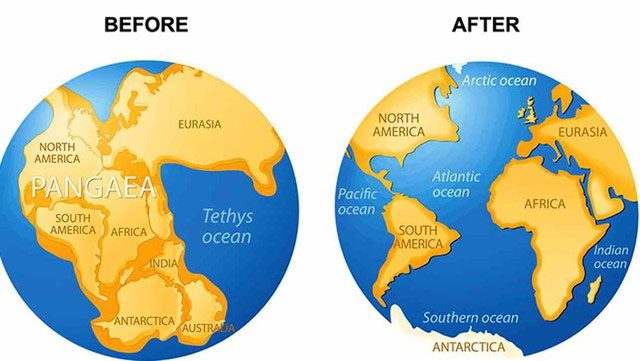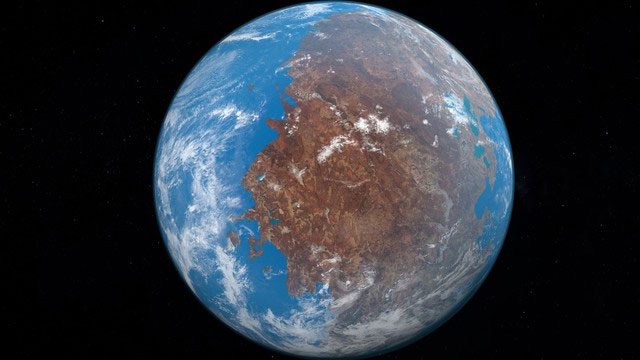Pangaea existed millions of years ago as a massive supercontinent covering one-third of the Earth’s surface. It was formed approximately 300 million years ago and began to break apart around 200 million years ago.
Pangaea (from Greek, meaning “all lands”) or the “All-Land,” was a supercontinent that existed during the Mesozoic Era of the Phanerozoic Eon before the continental drift process separated it into individual continents. The term first emerged in the early 20th century when Alfred Wegener observed that the continents appeared to fit together like pieces of a jigsaw puzzle. He later proposed the continental drift theory to explain the shape and positioning of continents and first used the term “Pangaea” at a symposium in 1927. Over time, this theory evolved into the modern theory of plate tectonics.
In Chinese, it is referred to as “Gǔ Bàn Dà Lù”, a name derived from an ancient Chinese mythology. This tale refers to Pangu, the creator of the universe and all things. In the initial chaos, Pangu used a gigantic axe to separate heaven and earth. Over time, parts of his body transformed into various aspects of the world, such as his breath becoming the wind, his voice becoming thunder, his left eye becoming the sun, and his right eye becoming the moon, while his limbs and body turned into the four poles and the center of the Earth.

Pangaea was a supercontinent that existed during the Mesozoic Era (Phanerozoic Eon).
The Formation of Pangaea
The formation of Pangaea was the result of years of land formation and movement. Millions of years ago, convection in the Earth’s mantle caused new material to emerge on the surface of the rifts between tectonic plates. As this new material appeared, it either caused continents to move away from the rift. Eventually, the continents collided and merged into a supercontinent, which is how Pangaea came into existence.
After numerous movements and collisions, around 300 million years ago, the ancient northwestern region of Gondwana (near Antarctica) collided with southern Europe and the Americas, forming a massive continent. After a while, Angaran (near the Arctic) began moving south and merged with the developing northern continent of Europe and America, resulting in the supercontinent later known as Pangaea. This process concluded about 270 million years ago.
Additionally, there was a continent called Cathay, which included northern and southern China and was never part of the supercontinent. Once fully formed, Pangaea covered about one-third of the Earth’s surface, surrounded by another massive ocean known as Panthalassa.

Continents collided and merged into a supercontinent, which is how Pangaea came into existence.
The Components of Pangaea
About 200 million years ago, Pangaea began the process of separation, using mechanisms similar to its formation, specifically the movement of tectonic plates triggered by mantle convection. Just as Pangaea formed through new material emerging from the rift, the appearance of new material also contributed to the breakup of the supercontinent. Scientists believe that the initial point for Pangaea’s eventual breakup was a weak area in the Earth’s crust. In this area, magma rose to the surface, creating a volcanic rift. Over time, this rift expanded into a massive basin, initiating the breakup of Pangaea.
The Formation of Oceans
As Panthalassa encroached on the newly formed land, different oceans began to form. The first ocean to form was the Atlantic Ocean. Approximately 180 million years ago, a portion of the Atlantic Ocean began to take shape between North America and northwest Africa. The South Atlantic was formed about 140 million years ago when the southwestern part of South America and Africa began to separate.
When India separated from Antarctica and Australia, the Indian Ocean emerged. Around 80 million years ago, North America and Europe, Australia and Antarctica, India and Madagascar, along with other landmasses, also began to separate. Over millions of years, these continents shifted to their current positions.

The first ocean to form was the Atlantic Ocean.
Evidence of Pangaea’s Existence
However, not everyone believes that Pangaea ever existed, but experts supporting this hypothesis present a multitude of evidence. One of the most convincing pieces of evidence is how the continents merged. Other evidence for Pangaea’s existence includes the distribution of fossils, unique patterns in rock formations around the world, and the global distribution of coal.
Fitting Shapes of Continents
As Alfred Wegener, the founder of the continental drift theory, observed in the early 20th century, the continents on Earth look like puzzle pieces that fit together. This is one of the most crucial pieces of evidence for the existence of Pangaea. The most striking examples are the northwest coast of Africa and the east coast of South America. In these locations, the two continents appear to have been connected at some point in the past, and many believe this occurred during the time of Pangaea.
Fossil Distribution
Archaeologists have uncovered fossil remains of ancient land and freshwater species on continents that are now separated by thousands of miles of ocean. For example, similar freshwater reptile fossils have been found in both Africa and South America. Since these non-saltwater creatures could not have crossed the Atlantic Ocean, their fossils prove that these two continents were certainly once connected.

The global distribution of coal is also evidence of Pangaea’s existence.
Rock Patterns
Patterns in rock formations provide another piece of evidence that Pangaea existed. Geologists have discovered unique rock patterns on distant continents. Structures along coastlines were initially thought to be clues to the puzzle-like arrangement of continents years ago, and geologists later confirmed the existence of Pangaea. This is because they found that even rock formations on continents that appeared to have once been connected also fit together perfectly. This indicates that the continents were certainly separated, as the presence of identical rock layers cannot be mere coincidence.
Coal Distribution
The global distribution of coal is also evidence of Pangaea’s existence, similar to the distribution of fossils. Coal typically forms in warm, humid climates. However, scientists have also found coal beneath the freezing cold layers in Antarctica. To explain this phenomenon, it is suggested that this icy continent once lay in a different location on Earth and had a climate vastly different from today – conditions that supported the formation of coal.

Pangaea may not have been the only supercontinent to ever exist.
Based on evidence obtained through plate tectonic studies, Pangaea may not have been the only supercontinent to ever exist. In fact, archaeological data through the combination of rock types and fossil findings suggest that the formation and breakup of a supercontinent similar to Pangaea may have occurred multiple times throughout history.
Scientists predict that the formation of supercontinents will continue to occur. Today, the continents of the world are gradually moving from the mid-Atlantic ridge towards the center of the Pacific Ocean. It is believed that these continents will eventually collide in about 80 million years.


















































